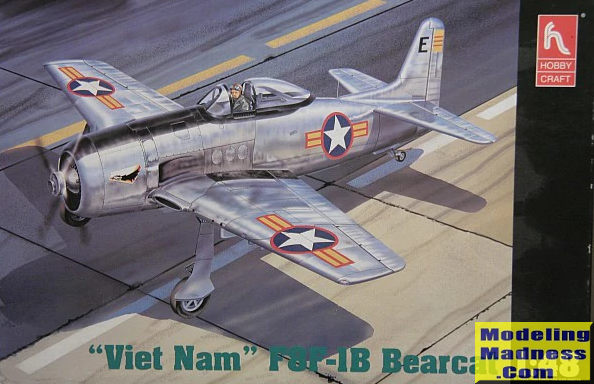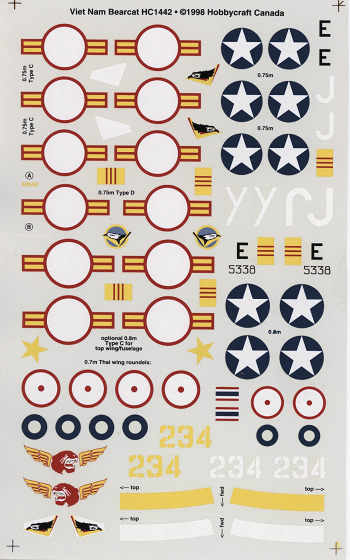
Hobbycraft 1/48 F8F-1B 'Vietnam Bearcat'
|
KIT # |
1442 |
|
PRICE: |
$16.98 when new |
|
DECALS: |
Four aircraft |
|
REVIEW : |
|
|
NOTES: |
1998 Boxing |

|
HISTORY |
Grumman's stubby little Bearcat was the result of putting the largest engine into the smallest possible airframe that could accommodate all the usual required things for use on aircraft carriers. The aircraft itself was probably the finest piston-engined Naval fighter to be produced, though I'm sure there are some FAA protagonists that would disagree! The aircraft was all that the Navy wanted and more, however, the end of the war in the Pacific meant that there was no real need for the aircraft and proposed construction was severely curtailed, resulting in only 1,265 aircraft being produced between August 1944 and May 1949. No Bearcats saw action on American carriers either during WW2 or during Korea, as by that time, jets were already in place as fighters. In civilian hands, the Bearcat proved itself to be a superb air racer, with Darryl Greenameyer's Conquest I finally beating the world speed record for prop driven aircraft in 1969, 30 years after it was last set by the Me-209v1.
It was the French who ended up taking the Bearcat into combat. As is so often the case, it was used as a ground attack platform, and not as a fighter. To my knowledge, the F8F never shot down an aerial victim. France was the first country to receive export Bearcats in 1951; all of the 140 delivered being F8F-1 and F8F-1B variants. The -1B were cannon armed. All of these aircraft were delivered to French Indochina, where the French were having a bit of trouble with Communist insurgents.
Eventually ten squadrons were outfitted with the Bearcat and all of them served in Indochina. They were all used for ground support, though in reality there were never more than four of them on active duty at any one time. This happened during the siege of Dien Bien Phu in early 1954 during the height of the fighting. Besides being operated as fighter bombers, a few were given to reconnaissance squadrons, where a camera pod was placed on the centerline rack.
When the French part of the Indochina war ended in mid 1954, the French then turned over its Bearcats to the South Vietnamese and Thai Air Forces. The US also supplied Bearcats to Thailand, all of them F8F-1 and -1Bs. The -1Bs were never in operational service and were used for spares. Thailand was the final operator of the Bearcat, striking the last one from service in 1963.
|
THE KIT |
 Hobbycraft's
kit of the Bearcat is really very nicely done. It is pretty complete and offers
everything that one would look for in a 1990s model kit. Detail is good and
enough for most modelers, with crisp engraved panel lines and a nicely detailed
interior and wheel wells. Those who have criticized this kit have generally
pointed to the engine cowling as probably the biggest area of concern. They say
that the cowling edge is too sharp and needs to be more rounded. A number of
aftermarket cowlings are available for those who wish to replace this item.
There are also aftermarket interiors and wheel wells out there.
Hobbycraft's
kit of the Bearcat is really very nicely done. It is pretty complete and offers
everything that one would look for in a 1990s model kit. Detail is good and
enough for most modelers, with crisp engraved panel lines and a nicely detailed
interior and wheel wells. Those who have criticized this kit have generally
pointed to the engine cowling as probably the biggest area of concern. They say
that the cowling edge is too sharp and needs to be more rounded. A number of
aftermarket cowlings are available for those who wish to replace this item.
There are also aftermarket interiors and wheel wells out there.
 Typical
of kits, there are the needed parts only to do an F8F-1B. The kit is designed
for the taller tail and different cowling of the -2, which are not included in
this kit. This version also has the additional underwing armament of napalm
tanks and bombs. Also included is a two-piece canopy so that you
can show off the interior. I am puzzled by why some other companies still do not
provide this option as it seems like such a simple thing.
Typical
of kits, there are the needed parts only to do an F8F-1B. The kit is designed
for the taller tail and different cowling of the -2, which are not included in
this kit. This version also has the additional underwing armament of napalm
tanks and bombs. Also included is a two-piece canopy so that you
can show off the interior. I am puzzled by why some other companies still do not
provide this option as it seems like such a simple thing.
Hobbycraft has often been derided on its instruction sheet. Basically for it being weak in calling out colors in the construction steps. This one is no exception. There is no hint as to what color landing gear struts, wheels wells, cockpit interior, or any other part of the inside of the plane should be painted! It is only when the builder looks at some small boxes in the decaling section that one finds information on the cockpit colors. Like most builders and reviewers, I find this to be an incredible oversight on the part of Hobbycraft. Sure, more experienced modelers will have a good idea of what to paint these parts, but what about those who don't?
The decals provided are for four aircraft. Three of them are South Vietnamese. Two are in the overall sea blue scheme from 1958 or so and differ only in nose number. The third is overall unpainted metal with a black anti-glare panel on the nose. THe fourth is one from Thailand and it is also in sea blue. There is some doubt as to the color of the nose number so you are offered one in yellow and one in white. In addition to the usual markings, Hobbycraft have included a smaller decal sheet that has canopy frames on it. These are in two shades of blue and aluminum. Many prefer to use things like this as their canopy masking abilities are not that good. Hobbycraft should be lauded for including them as well.
|
CONCLUSIONS |
All in all, it builds into a really nice model right out of the box, while adding all the aftermarket made for it will just add that much more to it. It is not that difficult to build and if you want to read a full build review of the French boxingis kit, go here.
|
REFERENCES |
Grumman Aircraft since 1929 by Rene J Francillon, 1989
August 2017
Copyright ModelingMadness.com. All rights reserved.
If you would like your product reviewed fairly and quickly by a site that has over 1,100 visits a day, please contact me or see other details in the Note to Contributors.